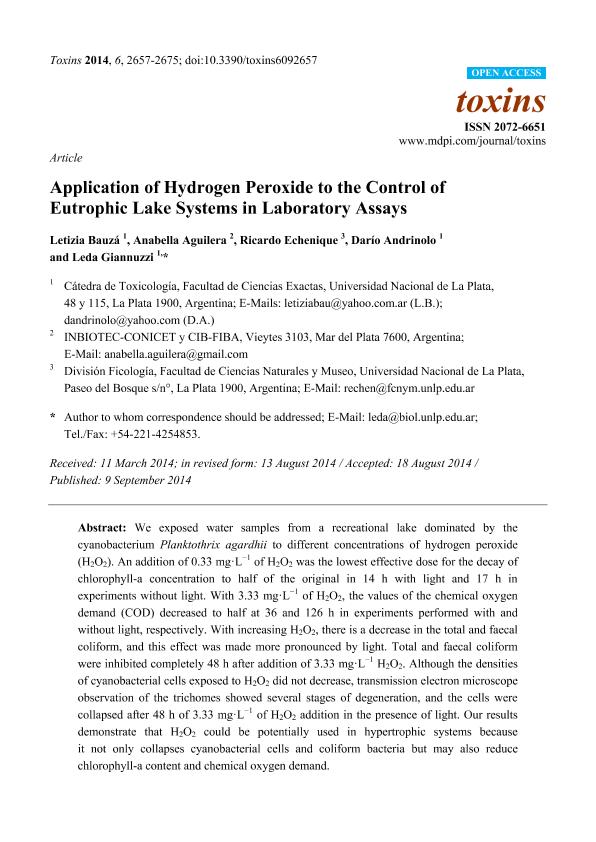Artículo
Application of hydrogen peroxide to the control of eutrophic lake systems in laboratory assays
Bauzá, Letizia ; Aguilera, Anabella
; Aguilera, Anabella ; Etchenique, Roberto Argentino
; Etchenique, Roberto Argentino ; Andrinolo, Dario
; Andrinolo, Dario ; Giannuzzi, Leda
; Giannuzzi, Leda
 ; Aguilera, Anabella
; Aguilera, Anabella ; Etchenique, Roberto Argentino
; Etchenique, Roberto Argentino ; Andrinolo, Dario
; Andrinolo, Dario ; Giannuzzi, Leda
; Giannuzzi, Leda
Fecha de publicación:
09/2014
Editorial:
Molecular Diversity Preservation International
Revista:
Toxins
ISSN:
2072-6651
Idioma:
Inglés
Tipo de recurso:
Artículo publicado
Clasificación temática:
Resumen
We exposed water samples from a recreational lake dominated by the cyanobacterium Planktothrix agardhii to different concentrations of hydrogen peroxide (H2O2). An addition of 0.33 mg·L−1 of H2O2 was the lowest effective dose for the decay of chlorophyll-a concentration to half of the original in 14 h with light and 17 h in experiments without light. With 3.33 mg·L−1 of H2O2, the values of the chemical oxygen demand (COD) decreased to half at 36 and 126 h in experiments performed with and without light, respectively. With increasing H2O2, there is a decrease in the total and faecal coliform, and this effect was made more pronounced by light. Total and faecal coliform were inhibited completely 48 h after addition of 3.33 mg·L−1 H2O2. Although the densities of cyanobacterial cells exposed to H2O2 did not decrease, transmission electron microscope observation of the trichomes showed several stages of degeneration, and the cells were collapsed after 48 h of 3.33 mg·L−1 of H2O2 addition in the presence of light. Our results demonstrate that H2O2 could be potentially used in hypertrophic systems because it not only collapses cyanobacterial cells and coliform bacteria but may also reduce chlorophyll-a content and chemical oxygen demand.
Palabras clave:
Cyanobacteria
,
Chemical Oxygen Demand
,
Hydrogen Peroxide
,
Coliforms
Archivos asociados
Licencia
Identificadores
Colecciones
Articulos(CCT - LA PLATA)
Articulos de CTRO.CIENTIFICO TECNOL.CONICET - LA PLATA
Articulos de CTRO.CIENTIFICO TECNOL.CONICET - LA PLATA
Articulos(CIDCA)
Articulos de CENTRO DE INV EN CRIOTECNOLOGIA DE ALIMENTOS (I)
Articulos de CENTRO DE INV EN CRIOTECNOLOGIA DE ALIMENTOS (I)
Articulos(INBIOTEC)
Articulos de INSTITUTO DE INV. EN BIODIVERSIDAD Y BIOTECNOLOGIA
Articulos de INSTITUTO DE INV. EN BIODIVERSIDAD Y BIOTECNOLOGIA
Citación
Bauzá, Letizia; Aguilera, Anabella; Etchenique, Roberto Argentino; Andrinolo, Dario; Giannuzzi, Leda; Application of hydrogen peroxide to the control of eutrophic lake systems in laboratory assays; Molecular Diversity Preservation International; Toxins; 6; 9; 9-2014; 2657-2675
Compartir
Altmétricas



